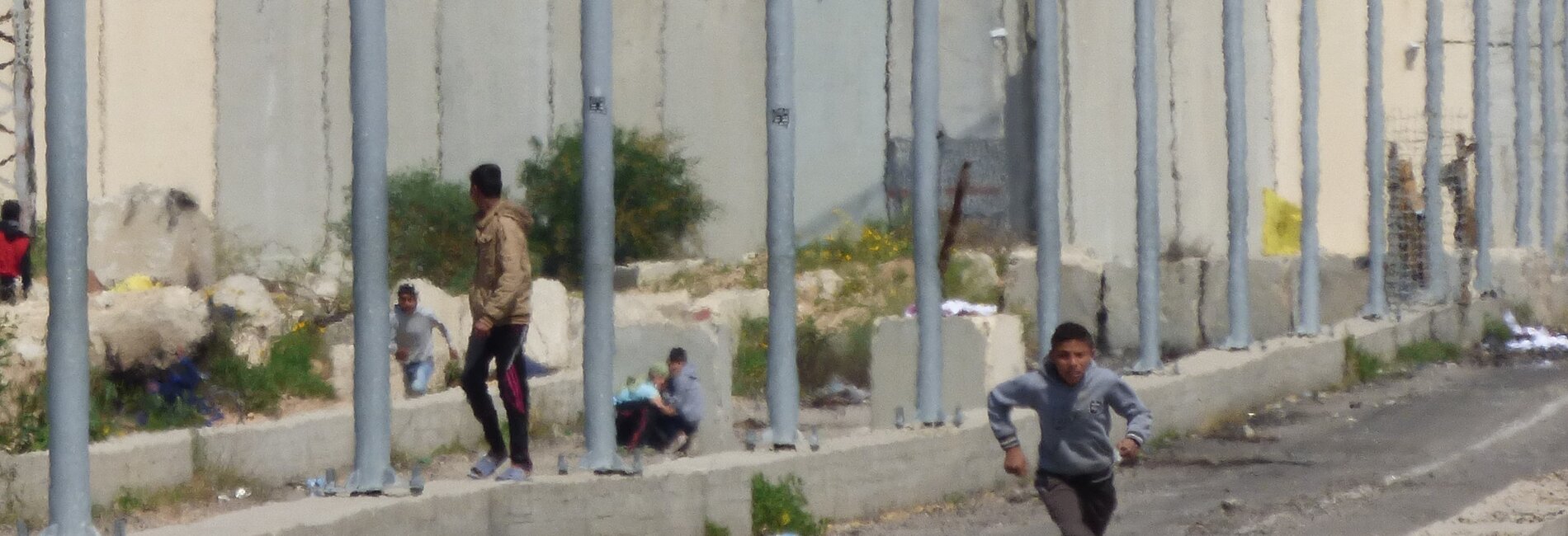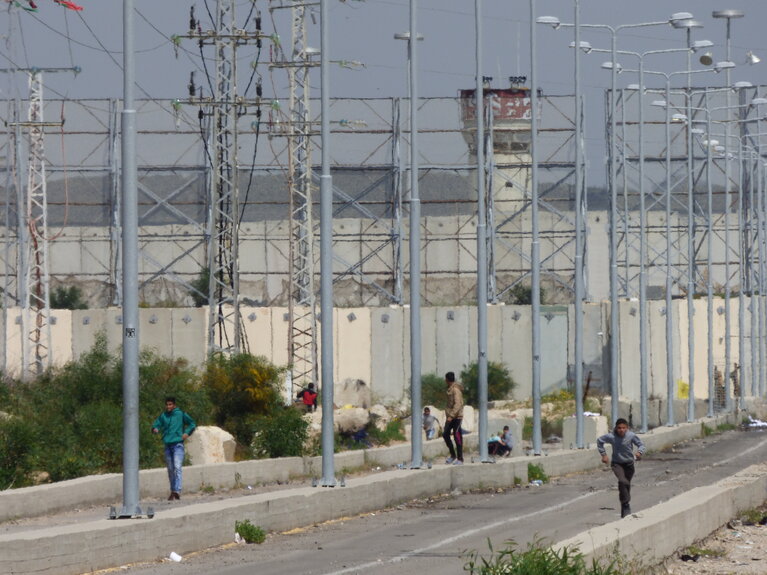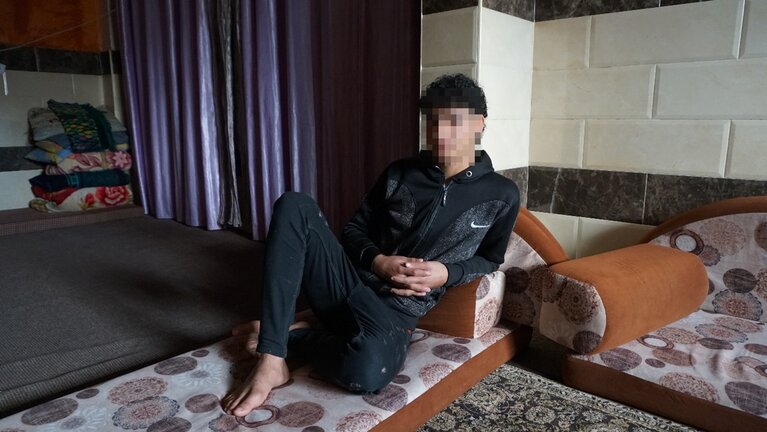Children arrested after fleeing from Gaza
“I have many dreams, but I am now convinced of the importance of remaining in Gaza in dignity, rather than crossing the border to Israel again”, says Yousef, a 19-year-old man from Gaza. When he was 17 years old, his thoughts were very different, and he says that his current belief was acquired at a very high cost.
Yousef’s family lives in Jabalia Camp, the largest and most populous refugee camp in the Gaza Strip. They suffer from poverty, and depend mainly on government cash assistance and on food provided by the United Nations Relief and Works Agency for Palestine Refugees in the Near East (UNRWA). When the Israeli government stopped issuing permits for people from Gaza to work in Israel in 2006, citing security concerns, Yousef’s father lost a good job.[1] Since then, the family’s financial situation has deteriorated, as it has for many other families in Gaza.
The poverty rate in Gaza was expected to reach 64 per cent at the end of 2020,[2] and the already dire socio-economic situation has deteriorated significantly since a second lockdown was imposed in August by the local authorities, to contain the transmission of COVID-19, with unemployment reaching 43 per cent in the fourth quarter of 2020.[3]
Yousef’s dream was to become a nurse, but university fees are expensive, and high marks are needed at the General Secondary Certificate – the Tawjihi – to get admitted. According to the Education Cluster, the quality of public education in Gaza is inadequate, with around 65 per cent of UNRWA and public schools operating on a double-shift system, and poor families struggling to buy basic education supplies and pay for school transportation for their children. In 2017-18 the dropout rate in public schools in Gaza was 1.94 per cent for basic education (grades from 1 to 9) and 5.98 per cent for secondary education (grades from 10 to 12).[4]
“In 2019, during my last school year, I decided to take a risk. My friend convinced me that if we managed to cross the perimeter fence [into Israel], we would get paid work and secure better conditions for ourselves and our families. We tried this because we had nothing to lose. The risk of being shot, arrested, or even killed by Israeli soldiers did not stop us, it was our only hope for a better life.”
One night, Yousef and his friend succeeded in crossing the fence. Some 200 metres inside Israel they heard heavy shooting and saw soldiers with dogs and strong lights. The soldiers ordered them to take off all their clothes, and Yousef remembers feeling very humiliated and panic-stricken. He says that he was blind-folded, insulted and heavily beaten when the soldiers took him to Shikma prison in the Israeli city of Ashkelon.[5]
“I was put in isolation and they interrogated me several times, again beating and insulting me. At that time, I did not know what happened to my friend. After 20 days, they finally moved me to another prison.”
He was transferred to Ofer prison in the West Bank, which is also operated by the Israeli authorities. There, he met other children from Gaza, including the friend with whom he crossed the perimeter fence. “In Ofer prison, prison officers finally allowed me to contact a lawyer.”
Between 2015 and 2019, at least 259 Gaza residents, including 96 children, were arrested by Israeli forces while crossing the perimeter fence into Israel. Israeli forces shot dead 24 people, including eight children, while 13 people, including six children, were injured while attempting to cross, according to a recent report by Al Mezan Center for Human Rights, a Palestinian organization based in Gaza.
Al Mezan interviewed 91 children like Yousef who had attempted to cross the perimeter fence into Israel between 2015 and 2019. According to the study, the main push factors included poverty, sometimes compounded by domestic violence; the poor quality of life in refugee camps or rural areas; and school drop-out.
More than a third of the children interviewed reported experiencing violence during the arrests. All the children reported being interrogated, and several claimed to have been subjected to various coercive and intimidating questioning methods, including sleep, food and water-deprivation, as well as violence, insults, and humiliation. During their entire period of incarceration, one third had reportedly not been allowed to see a lawyer, the vast majority were denied family visits and several were denied phone calls.
Yousef tried to make the best of his time in jail: “Poverty did not allow me nor any of my family members to attend university. My family does not have the money to secure even the minimum of decent food or to afford the cost of education. Because of this, I decided to study hard in prison and finally succeeded in getting my Tawjihi. I studied alone with my books; the other children were not interested. It was very difficult without any help, the place was not good, but I took the exam in prison and I got 63 per cent!”
The International Committee of the Red Cross (ICRC) informed his family that he was in prison and coordinated a visit by his mother. His family received a visit from a human rights organization which gave them some legal advice. When he turned 18, he was transferred to Nafha prison in southern Israel, where adults from Gaza were imprisoned.
According to the Al Mezan report, half of the children were released within 48 hours of being arrested, while others spent an average of five months in Israeli jails or military installations. According to Israeli human rights organization B’Tselem, in September 2020, 173 Palestinian children considered criminal offenders were detained or imprisoned in either Israel Defence Force (IDF) or Israel Prison Service (IPS) prisons and facilities.
When children are sent back to Gaza, according to the report, most are arrested and interrogated again, this time by Hamas security services, to verify whether they have become Israeli informants. The 91 children interviewed in the report were imprisoned for periods from a few days to over a week for interrogation, while one third reported being insulted or beaten. All the children were finally released after signing a pledge not to cross the perimeter fence again.
“After nearly ten months in different Israeli prisons, I finished my prison term, so I was released. Fortunately, I was not interrogated by Palestinian security services when I got back to Gaza. I still cannot believe that I returned safe and sound to my family. I still feel traumatized, especially from the first twenty days of torture and humiliation.”
Yousef cannot find work, and university is too expensive to afford. He is still traumatized, and his family is trying to convince him to seek treatment, but he refuses. In Gaza, there is no programme specifically dedicated to address the needs of former prisoners. However, the humanitarian community provides coordinated mental health and psychosocial support, specifically case management, group counselling, individual psychological support and legal aid services for children in conflict with the law, former prisoners included.[6] Yousef is one of 476,000 people in Gaza – including 234,000 children – in need of mental health and psychosocial support, as a direct or indirect result of the deteriorating humanitarian situation in the Gaza Strip.[7]
Referring to the situation of children in Gaza, the former Humanitarian Coordinator, Jamie McGoldrick, made this appeal in 2018, “We call on Israel, as well as the Palestinian Authority and the Hamas authorities in Gaza to put children’s rights ahead of any other considerations and to take immediate steps to alleviate their suffering.” The Convention on the Rights of the Child (CRC)[8] specifically states that “no child shall be subjected to torture or other cruel, inhuman or degrading treatment or punishment” and “the arrest, detention or imprisonment of a child shall be in conformity with the law and shall be used only as a measure of last resort and for the shortest appropriate period of time”.[9] Reversing the deteriorating humanitarian situation in Gaza is an important step towards guaranteeing children’s rights and giving them hope for the future, so that they do not feel compelled to try and leave the territory.
[1] The number of permits for Palestinian daily labourers from Gaza gradually decreased after 2000 with the beginning of the Second Intifada. The remaining permits were finally cancelled in 2006 when Hamas won the Palestinian parliamentary elections.
[2] OCHA, Humanitarian Needs Overview OPT 2021.
[3] World Bank, Economic Monitoring Report to the Ad Hoc Liaison Committee (2021).
[4] Source: Education Cluster. Data about school year 2019 – 2020 and 2020 – 2021 are not available due to COVID disruption.
[5] Available list of prisons and detection centres and their description.
[6] UNDP, UN Women and UNICEF, Promoting the Rule of Law in Palestine (Sawasya II) project.
[7] The Protection Cluster estimates that some 198,000 children in Gaza are in need of structured protection and psychosocial support, due to risk of severe and moderate mental health conditions, while nearly 36,000 children require individual case management. Additionally, over 242,000 adults in Gaza, including caregivers, are also in need of various MHPSS services. OCHA, Humanitarian Needs Overview OPT 2021.
[8] The Conventions on the Rights of the Child was adopted and opened for signature, ratification and accession by General Assembly resolution 44/25 of 20 November 1989 and entered into force on 2 September 1990.
[9] CRC: Articles 37(a) and 37(b).












